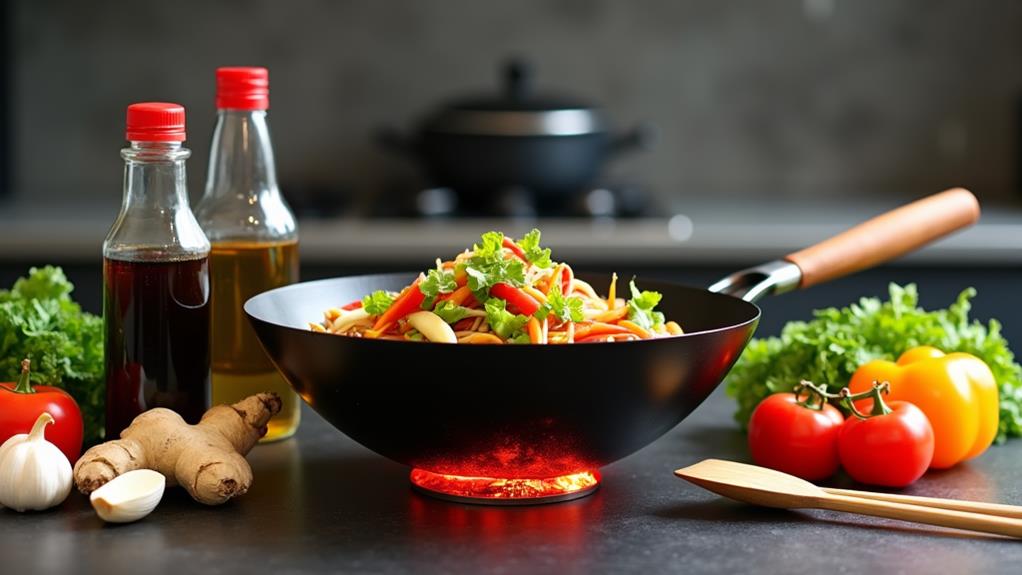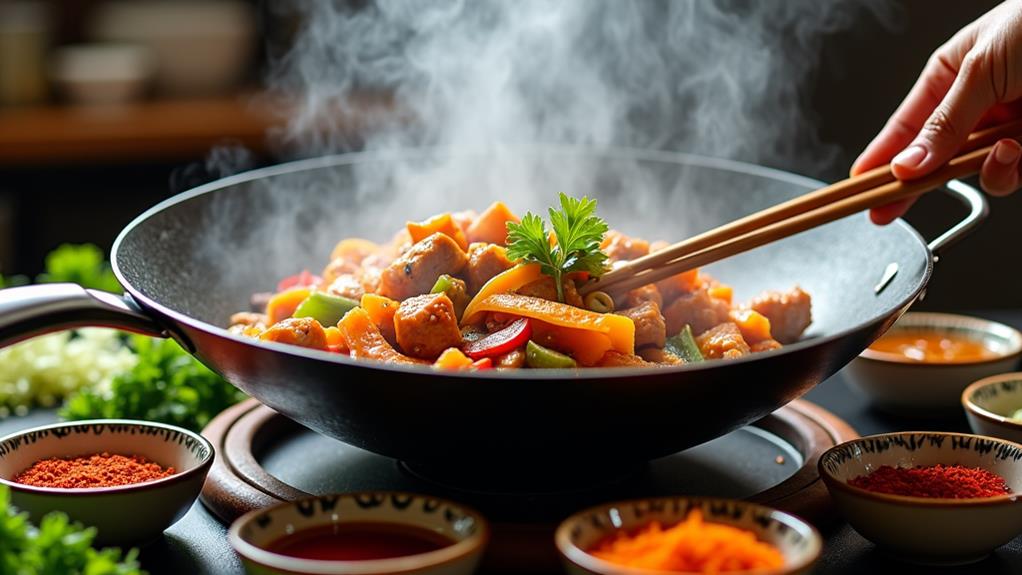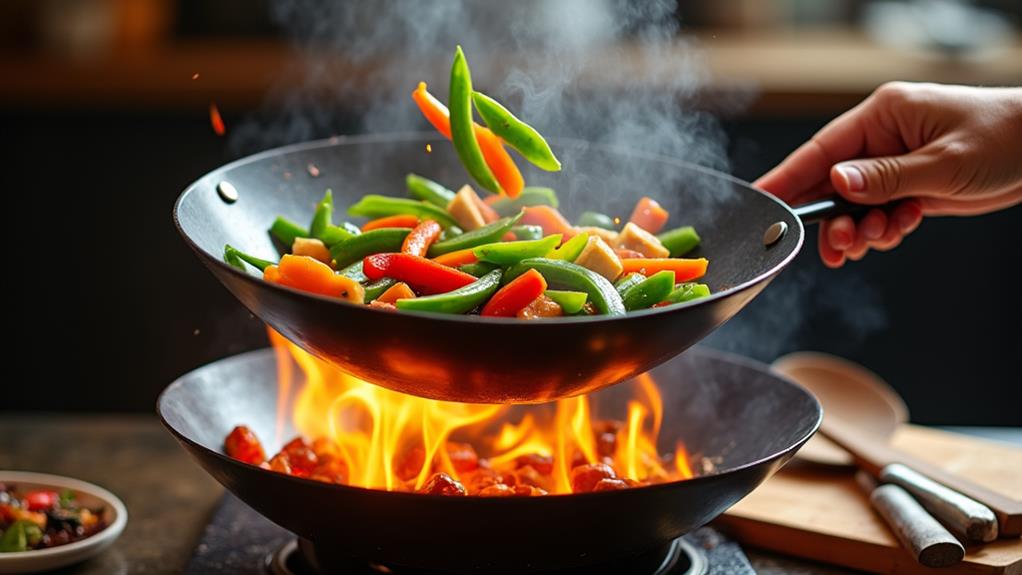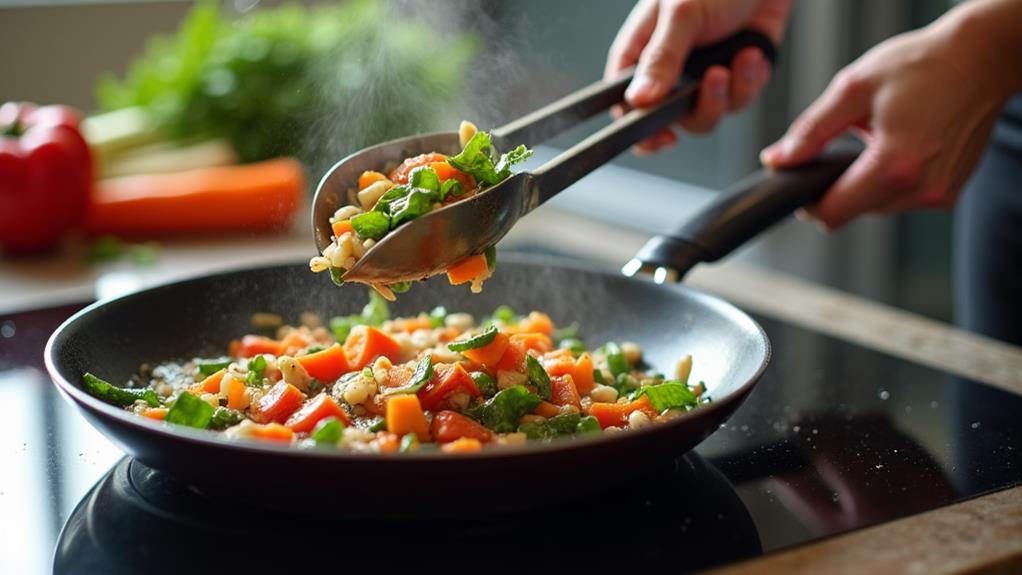To master stir-frying, start by selecting the right wok—carbon steel for quick heating or cast iron for heat retention. Preheat your wok until it's smoking hot before adding oil with a high smoke point. Keep ingredients moving constantly to prevent burning, and cook in batches to maintain high heat. Stock essential ingredients like soy sauce, garlic, ginger, and a variety of vegetables. Experiment with unique seasonings like Chinese five-spice or fermented sauces to elevate flavors. Proper timing and technique are crucial: set up an organized prep station and add ingredients in the right order. By mastering these elements, you'll unlock a world of vibrant, restaurant-quality stir-fries at home. The journey to culinary excellence awaits.
Choosing the Perfect Wok
The right wok can make or break your stir-fry experience. When selecting your ideal cooking companion, consider the various wok materials available. Carbon steel, a popular choice among culinary innovators, heats quickly and evenly, developing a natural non-stick surface over time.
Alternatively, cast iron offers excellent heat retention but requires more maintenance. For those seeking convenience, stainless steel woks provide durability and easy cleaning, though they may not distribute heat as effectively.
Wok shapes also play a crucial role in your stir-frying success. Traditional round-bottomed woks excel at heat distribution but may not be suitable for all stovetops. Flat-bottomed versions offer stability on electric and induction ranges, sacrificing some of the classic wok hei flavor.
Consider a hybrid design that combines the benefits of both shapes for versatility across cooking surfaces.
When choosing your wok, prioritize a size that accommodates your typical cooking volume while allowing ample space for tossing ingredients. Opt for a wok with a long handle for better control and a helper handle for easy lifting.
Heat Control Mastery
Mastering heat control is the cornerstone of successful stir-frying. It's the difference between a crisp, flavorful dish and a soggy, overcooked mess.
To elevate your sautéing techniques, you'll need to understand the interplay between your wok and heat source. Start by preheating your wok until it's smoking hot, then add your chosen oil. The right oil selection is crucial; opt for oils with high smoke points like peanut or avocado oil to withstand the intense heat.
As you cook, maintain consistent heat by adjusting your burner. Remember, stir-frying is a high-heat, quick-cooking method.
To achieve optimal results:
- Keep ingredients moving constantly
- Add dense vegetables first, followed by more delicate ones
- Remove the wok from heat briefly if it becomes too hot
Essential Stir-Fry Ingredients

Every successful stir-fry starts with a well-stocked pantry. To elevate your culinary game, you'll need to master the art of ingredient selection.
Begin with a diverse array of protein options, ranging from classic choices like chicken and beef to innovative alternatives such as tofu, tempeh, or even plant-based meat substitutes. These proteins serve as the foundation of your dish, providing essential nutrients and satisfying textures.
Next, explore the vast world of vegetable varieties. Incorporate crisp bell peppers, snap peas, and water chestnuts for a delightful crunch. Add depth with mushrooms, bok choy, and baby corn.
Don't shy away from experimenting with less common vegetables like lotus root or Chinese broccoli to add intrigue to your creations. For aromatics, garlic, ginger, and scallions are indispensable, infusing your stir-fry with bold flavors.
Stock up on sauces like soy sauce, oyster sauce, and hoisin to create complex flavor profiles. Finally, keep sesame oil, rice vinegar, and cornstarch on hand for finishing touches and thickening.
With these essential ingredients at your fingertips, you'll be ready to craft innovative stir-fry dishes that push culinary boundaries.
Timing and Technique Tips
According to expert chefs, timing is everything when it comes to stir-frying. Your success hinges on how well you manage the cooking process, from ingredient prep to the final toss in the wok.
To revolutionize your stir-fry game, set up a prep station before you begin. This organized approach ensures you're ready to add each component at the perfect moment.
Once you've mastered your prep station, focus on these key technique tips:
- Heat your wok until it's smoking hot before adding oil
- Cook ingredients in batches to maintain high heat
- Keep food moving constantly to prevent burning
Flavor-Boosting Seasoning Secrets

Beyond the basics of heat and timing, the true art of stir-frying lies in its seasoning. To elevate your dishes, you'll need to master the art of umami enhancement and spice combinations.
Start by experimenting with classic Asian seasonings like soy sauce, oyster sauce, and fish sauce. These ingredients add depth and complexity to your stir-fries, creating a rich flavor profile that'll tantalize your taste buds.
For a bold umami boost, try incorporating fermented ingredients such as miso paste or black bean sauce. These powerhouse seasonings pack a punch of savory goodness that'll transform your stir-fries from ordinary to extraordinary.
Don't shy away from unconventional spice combinations, either. Mix Chinese five-spice powder with a touch of cumin for a unique twist, or blend ginger, garlic, and lemongrass for a fragrant Thai-inspired dish.
Frequently Asked Questions
Can I Use Frozen Vegetables in a Stir-Fry?
You can definitely use frozen veggies in stir-fries! They're convenient and nutritious. To optimize texture, thaw and pat them dry first. For a game-changing stir-fry, mix frozen and fresh veggies for diverse textures and flavors.
How Do I Prevent My Stir-Fry From Becoming Too Watery?
Don't let your stir-fry become a soggy mess! Embrace these innovative cooking techniques: pat vegetables dry, crank up the heat, and use thickening agents in your stir fry sauces. You'll create a deliciously crisp masterpiece every time.
Are There Any Vegetarian Protein Alternatives Suitable for Stir-Frying?
You've got plenty of protein-packed options for your veggie stir-fry. Try firm tofu, tempeh, or seitan for meaty textures. Mix it up with edamame, lentils, or quinoa. Experiment with protein combinations to create innovative, satisfying dishes.
What's the Best Way to Clean and Maintain a Wok?
Imagine your wok as a loyal warrior, deserving of care. You'll want to season it regularly, scrub gently with hot water, and avoid soap. Dry thoroughly and store in a cool, dry place. Innovative wok seasoning techniques ensure longevity.
Can I Prepare Stir-Fry Ingredients in Advance for Quicker Cooking Later?
Absolutely! You'll revolutionize your stir-fry game by prepping vegetables ahead. Slice, dice, and store them in airtight containers. Don't forget to mix and refrigerate your sauces separately. You'll be ready to wok and roll in no time!
Final Thoughts
You've now unlocked the secrets to stir-fry mastery that'll make your taste buds dance with joy. With your new wok, heat control skills, and ingredient knowledge, you're ready to create culinary magic. Remember, timing is everything, and the right seasonings can elevate your dish from good to extraordinary. As you practice these techniques, you'll find yourself creating stir-fries that rival the best restaurants. So fire up that wok, and let your newfound expertise shine in every sizzling, flavorful bite.















